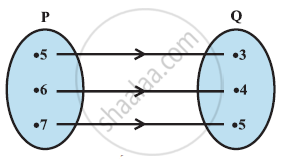Advertisements
Advertisements
Question
Let A = {1, 2, 3, 4}, B = {1, 5, 9, 11, 15, 16} and f = {(1, 5), (2, 9), (3, 1), (4, 5), (2, 11)}. Is the following true?
f is a function from A to B
Justify your answer in case.
Options
True
False
Solution
This statement is False.
Explanation:
Since (2, 9), (2, 11) f i.e., f contains two ordered pairs with the same first element. Hence, f is not a function from A to B.
RELATED QUESTIONS
The given figure shows a relationship between the sets P and Q. Write this relation
- in set-builder form.
- in roster form.
What is its domain and range?

Let R be the relation on Z defined by R = {(a, b): a, b ∈ Z, a – b is an integer}. Find the domain and range of R.
The relation f is defined by f(x) = `{(x^2,0<=x<=3),(3x,3<=x<=10):}`
The relation g is defined by g(x) = `{(x^2, 0 <= x <= 2),(3x,2<= x <= 10):}`
Show that f is a function and g is not a function.
Find the inverse relation R−1 in each of the cases:
(ii) R = {(x, y), : x, y ∈ N, x + 2y = 8}
Find the inverse relation R−1 in each of the cases:
(iii) R is a relation from {11, 12, 13} to (8, 10, 12] defined by y = x − 3.
Let R be a relation from N to N defined by R = {(a, b) : a, b ∈ N and a = b2}. Is the statement true?
(a, b) ∈ R implies (b, a) ∈ R
Justify your answer in case.
If R = {(x, y) : x, y ∈ Z, x2 + y2 ≤ 4} is a relation defined on the set Z of integers, then write domain of R.
If R is a relation from set A = (11, 12, 13) to set B = (8, 10, 12) defined by y = x − 3, then write R−1.
If A = [1, 2, 3], B = [1, 4, 6, 9] and R is a relation from A to B defined by 'x' is greater than y. The range of R is
Let R be a relation on N defined by x + 2y = 8. The domain of R is
If R is a relation from a finite set A having m elements of a finite set B having n elements, then the number of relations from A to B is
If R is a relation on a finite set having n elements, then the number of relations on A is
If P = {1, 2, 3) and Q = {1, 4}, find sets P × Q and Q × P
Select the correct answer from given alternative
If A = {a, b, c} The total no. of distinct relations in A × A is
Answer the following:
Show that the following is an equivalence relation
R in A = {x ∈ Z | 0 ≤ x ≤ 12} given by R = {(a, b)/|a − b| is a multiple of 4}
Let A = {1, 2, 3, 7} and B = {3, 0, –1, 7}, the following is relation from A to B?
R1 = {(2, 1), (7, 1)}
Let A = {1, 2, 3, 7} and B = {3, 0, –1, 7}, the following is relation from A to B?
R3 = {(2, –1), (7, 7), (1, 3)}
Let A = {1, 2, 3, 7} and B = {3, 0, –1, 7}, the following is relation from A to B?
R4 = {(7, –1), (0, 3), (3, 3), (0, 7)}
Let A = {1, 2, 3, 4, …, 45} and R be the relation defined as “is square of ” on A. Write R as a subset of A × A. Also, find the domain and range of R
Let A = {9, 10, 11, 12, 13, 14, 15, 16, 17} and let f : A → N be defined by f(n) = the highest prime factor of n ∈ A. Write f as a set of ordered pairs and find the range of f
Discuss the following relation for reflexivity, symmetricity and transitivity:
Let A be the set consisting of all the female members of a family. The relation R defined by “aRb if a is not a sister of b”
Let X = {a, b, c, d} and R = {(a, a), (b, b), (a, c)}. Write down the minimum number of ordered pairs to be included to R to make it equivalence
Let P be the set of all triangles in a plane and R be the relation defined on P as aRb if a is similar to b. Prove that R is an equivalence relation
On the set of natural numbers let R be the relation defined by aRb if 2a + 3b = 30. Write down the relation by listing all the pairs. Check whether it is transitive
Choose the correct alternative:
Let X = {1, 2, 3, 4} and R = {(1, 1), (1, 2), (1, 3), (2, 2), (3, 3), (2, 1), (3, 1), (1, 4), (4, 1)}. Then R is
Is the following relation a function? Justify your answer
R1 = `{(2, 3), (1/2, 0), (2, 7), (-4, 6)}`
Is the given relation a function? Give reasons for your answer.
f = {(x, x) | x is a real number}
Let N denote the set of all natural numbers. Define two binary relations on N as R1 = {(x, y) ∈ N × N : 2x + y = 10} and R2 = {(x, y) ∈ N × N : x + 2y = 10}. Then ______.
